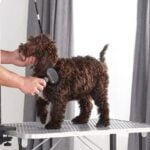Table of Contents
The Portuguese Water Dog is known for its curly, water-resistant coat and playful nature. Proper grooming is essential to keep their coat healthy, clean, and tangle-free. This guide provides valuable insights into the grooming needs of the Portuguese Water Dog, ensuring your canine companion looks and feels their best.

1. Regular Brushing
Regular brushing is crucial to prevent matting and tangling:
- Frequency: Brush your Portuguese Water Dog at least 2-3 times a week.
- Tools: Use a slicker brush and a comb to remove tangles and keep the coat smooth.
- Technique: Start at the base of the coat and work your way up to avoid painful pulling.
2. Bathing
Bathing helps maintain a clean and healthy coat:
- Frequency: Bathe your dog every 4-6 weeks or as needed based on their activity level.
- Shampoo: Use a mild, dog-specific shampoo to avoid skin irritation.
- Drying: Thoroughly dry your dog’s coat with a towel and a blow dryer on a low heat setting to prevent dampness and matting.
3. Coat Trimming
Regular trimming keeps the coat manageable and neat:
- Frequency: Trim your Portuguese Water Dog’s coat every 6-8 weeks.
- Styles: Common styles include the “retriever clip” (short all over) and the “lion clip” (short body with longer mane and tail).
- Professional Grooming: Consider taking your dog to a professional groomer if you are not comfortable trimming the coat yourself.
4. Ear Cleaning
Regular ear cleaning prevents infections and keeps ears healthy:
- Frequency: Check and clean your dog’s ears weekly.
- Tools: Use a vet-recommended ear cleaner and cotton balls.
- Technique: Gently wipe the outer ear and avoid inserting anything deep into the ear canal.
5. Nail Trimming
Trimming your dog’s nails is essential for their comfort and health:
- Frequency: Trim nails every 3-4 weeks or as needed.
- Tools: Use a nail clipper or grinder designed for dogs.
- Technique: Trim small amounts at a time to avoid cutting into the quick, which can cause bleeding and pain.
6. Dental Care
Good dental hygiene is crucial for overall health:
- Brushing: Brush your dog’s teeth several times a week with a dog-specific toothbrush and toothpaste.
- Dental Chews: Provide dental chews to help clean teeth and freshen breath.
- Vet Check-Ups: Schedule regular veterinary dental check-ups to monitor and maintain oral health.
7. Eye Care
Regular eye care keeps your dog’s eyes healthy and clear:
- Checking: Check your dog’s eyes daily for any signs of irritation or infection.
- Cleaning: Use a damp, clean cloth to gently wipe away any discharge from the corners of the eyes.
- Vet Visits: Consult your vet if you notice excessive tearing, redness, or other signs of eye problems.
Conclusion on Grooming Needs of the Portuguese Water Dog
Meeting the grooming needs of the Portuguese Water Dog involves regular brushing, bathing, coat trimming, ear cleaning, nail trimming, dental care, and eye care. By maintaining a consistent grooming routine, you can ensure your Portuguese Water Dog remains healthy, comfortable, and looking their best. For more information on dog grooming and care, visit the ASPCA and AKC.
FAQs on Grooming Needs of the Portuguese Water Dog
How often should I brush my Portuguese Water Dog’s coat?
Brush your Portuguese Water Dog’s coat at least 2-3 times a week to prevent matting and tangles.
What type of shampoo is best for my Portuguese Water Dog?
Use a mild, dog-specific shampoo to avoid skin irritation and maintain a healthy coat.
How can I keep my dog’s ears clean and healthy?
Check and clean your dog’s ears weekly using a vet-recommended ear cleaner and cotton balls. Avoid inserting anything deep into the ear canal.
When should I trim my Portuguese Water Dog’s nails?
Trim your dog’s nails every 3-4 weeks or as needed, ensuring you do not cut into the quick to avoid pain and bleeding.
Why is dental care important for my Portuguese Water Dog?
Good dental hygiene helps prevent oral health issues and contributes to your dog’s overall health. Brush their teeth regularly and provide dental chews.
What should I do if I notice eye problems in my Portuguese Water Dog?
If you notice excessive tearing, redness, or other signs of eye problems, consult your vet for a thorough examination and appropriate treatment.











